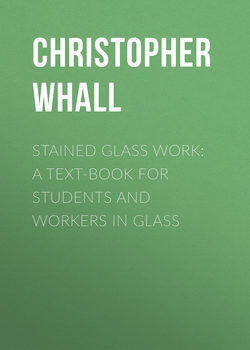Читать книгу Stained Glass Work: A text-book for students and workers in glass - Christopher Whall - Страница 4
PART I
CHAPTER I
INTRODUCTORY, AND CONCERNING THE RAW MATERIAL
ОглавлениеYou are to know that stained glass means pieces of coloured glasses put together with strips of lead into the form of windows; not a picture painted on glass with coloured paints.
You know that a beer bottle is blackish, a hock bottle orange-brown, a soda-water bottle greenish-white—these are the colours of the whole substance of which they are respectively made.
Break such a bottle, each little bit is still a bit of coloured glass. So, also, blue is used for poison bottles, deep green and deep red for certain wine glasses, and, indeed, almost all colours for one purpose or another.
Now these are the same glass, and coloured in the same way as that used for church windows.
Such coloured glasses are cut into the shapes of faces, or figures, or robes, or canopies, or whatever you want and whatever the subject demands; then features are painted on the faces, folds on the robes, and so forth—not with colour, merely with brown shading; then, when this shading has been burnt into the glass in a kiln, the pieces are put together into a picture by means of grooved strips of lead, into which they fit.
This book, it is hoped, will set forth plainly how these things are done, for the benefit of those who do not know; and, for the benefit of those who do know, it will examine and discuss the right principles on which windows should be made, and the rules of good taste and of imagination, which make such a difference between beautiful and vulgar art; for you may know intimately all the processes I have spoken of, and be skilful in them, and yet misapply them, so that your window had better never have been made.
Skill is good if you use it wisely and for good end; but craft of hand employed foolishly is no more use to you than swiftness of foot would be upon the broad road leading downwards—the cripple is happier.
A clear and calculating brain may be used for statesmanship or science, or merely for gambling. You, we will say, have a true eye and a cunning hand; will you use them on the passing fashion of the hour—the morbid, the trivial, the insincere—or in illustrating the eternal truths and dignities, the heroisms and sanctities of life, and its innocencies and gaieties?
This book, then, is divided into two parts, of which the intention of one is to promote and produce skilfulness of hand, and of the other to direct it to worthy ends.
The making of glass itself—of the raw material—the coloured glasses used in stained-glass windows, cannot be treated of here. What are called "Antiques" are chiefly used, and there are also special glasses representing the ideals and experiments of enthusiasts—Prior's "Early English" glass, and the somewhat similar "Norman" glass. These glasses, however, are for craftsmen of experience to use: they require mature skill and judgment in the using; to the beginner, "Antiques" are enough for many a day to come.
How to know the Right and Wrong Sides of a Piece of "Antique" Glass.—Take up a sheet of one of these and look at it. You will notice that the two sides look different; one side has certain little depressions as if it had been pricked with a pin, sometimes also some wavy streaks. Turn it round, and, looking at the other side, you still see these things, but blurred, as if seen through water, while the surface itself on this side looks smooth; what inequalities there are being projections rather than depressions. Now the side you first looked at is the side to cut on, and the side to paint on, and it is the side placed inwards when the window is put up.
The reason is this. Glass is made into sheets by being blown into bubbles, just as a child blows soap-bubbles. If you blow a soap-bubble you will see streaks playing about in it, just like the wavy streaks you notice in the glass.
The bubble is blown, opened at the ends, and manipulated with tools while hot, until it is the shape of a drain-pipe; then cut down one side and opened out upon a flattening-stone until the round pipe is a flat sheet; and it is this stone which gives the glass the different texture, the dimpled surface which you notice.
Some glasses are "flashed"; that is to say, a bubble is blown which is mainly composed of white glass; but, before blowing, it is also dipped into another coloured glass—red, perhaps, or blue—and the two are then blown together, so that the red or blue glass spreads out into a thin film closely united to, in fact fused on to, and completely one with, the white glass which forms the base; most "Ruby" glasses are made in this way.
